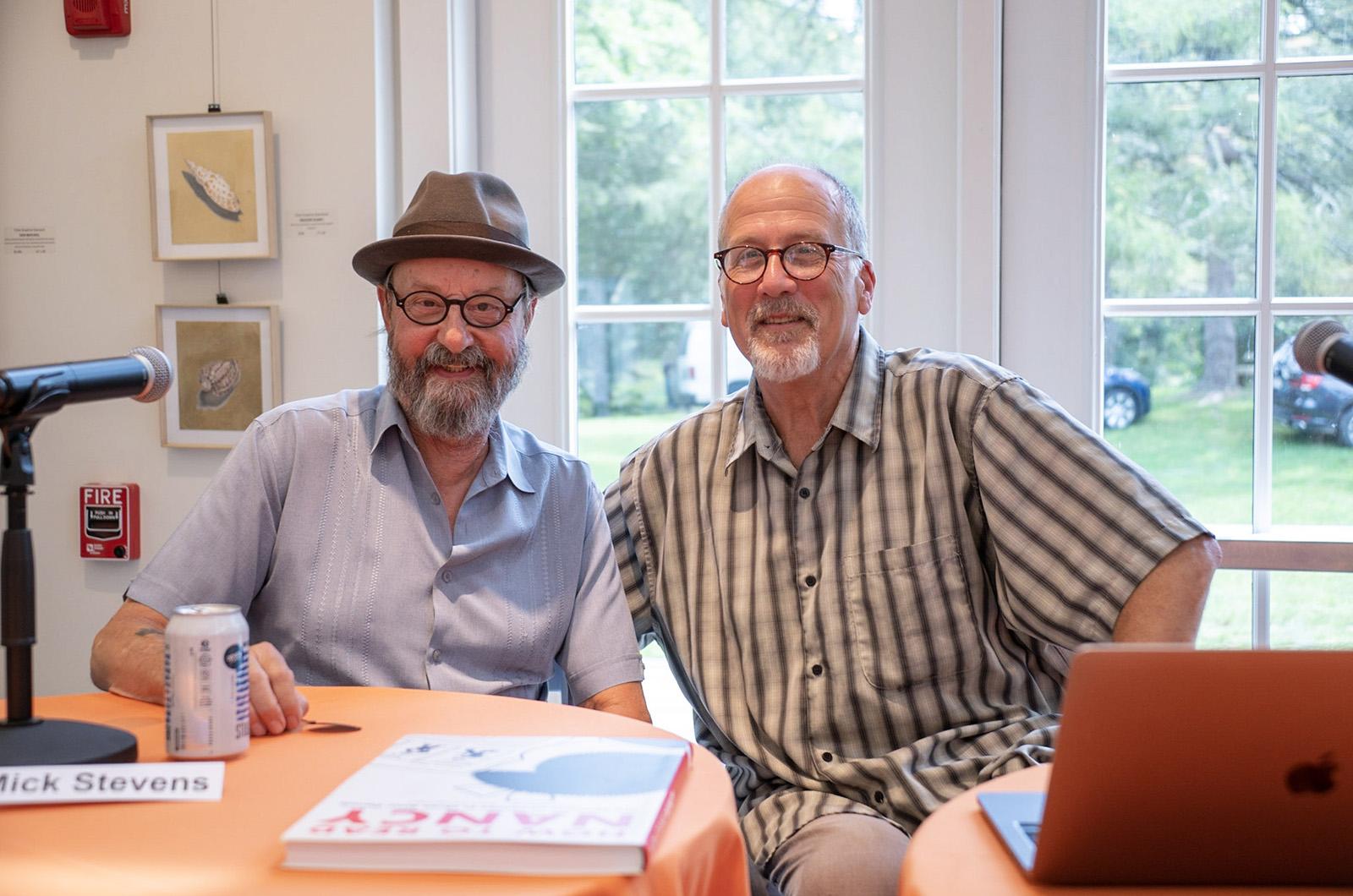Two popular New Yorker magazine cartoonists, who also happen to be West Tisbury neighbors and dog-walking partners, shared the stage at Featherstone Center for the Arts in Oak Bluffs Monday for a two-handed talk about the craft they share.
Discussing slides of their work, trading stories from their careers and cracking wise with the casual ease of longtime friends, Mick Stevens and Paul Karasik drew frequent gusts of laughter from their audience in the art center’s Francine Kelly Gallery.
“I think the fewer lines it takes to express the idea, the better, plus I’m really lazy,” deadpanned Mr. Stevens, whose hilariously quirky drawings have appeared in The New Yorker for more than 50 years.
His first sale, Mr. Stevens said, is still being reprinted: a desolate landscape captioned Life Without Mozart, inspired when his cassette player noisily chewed up a symphony tape he was listening to while drawing.
When he and Mr. Karasik began walking their dogs together some two decades ago, Mr. Stevens encouraged his neighbor — already a celebrated graphic storyteller — to try his own hand at selling gags to the taste-making magazine.
“I dreamed about being a New Yorker cartoonist. My parents had the albums of New Yorker cartoons on the table,” said Mr. Karasik, who had already studied with leading narrative cartoonists Will Eisner, Harvey Kurtzman and Art Spiegelman and published an acclaimed collaboration with David Mazzucchelli.
“And then Mick said, ‘Well, you know, this is what I do and this is how to do it.’”
Mr. Karasik adopted his neighbor’s workmanlike approach, drafting 10 gags a week, month in and month out, for consideration by the New Yorker’s cartoon editor.
“I think it took me about a year and a half of 10 drawings every week to actually make a sale,” Mr. Karasik said, showing a captionless image of a corporate meeting at one end of a boardroom table that extends out over a nearby seawall, becoming a plank where a suited man teeters forlornly as sharks swim below him.
“This was one of the greatest days of my life, selling a cartoon to the New Yorker,” Mr. Karasik recalled.
Mr. Stevens said it took some three years to sell his first New Yorker cartoon, and another six months to sell a second. Today, the magazine has about 30 of his that it has purchased but not published yet, and he’s still submitting 10 gags a week.
Occasionally, Mr. Stevens said, one of them is stripped of its caption for the weekly reader contest, which features one of his drawings in the current issue.
Both artists credited the nearly 100-year-old New Yorker with developing the art of the single-panel cartoon, as well as keeping it alive in the 21st century.
“This is sort of the last mag standing, as it were,” said Mr. Stevens, recalling when New York City had multiple publishers buying original gags.
“There were dozens of magazines, from the men’s magazines to The New Yorker and everything in between, and a cartoonist could walk around town with his — I say ‘his’ portfolio, tellingly,” Mr. Stevens said, acknowledging that the field was overwhelmingly male until Roz Chast made her New Yorker debut in 1978.
“She hit right away, because her style is so strong,” Mr. Stevens said.
“I think some people are so gifted and unique, that the art director looks at it and goes ‘whoa"...and Roz Chast is a really good example of that,” he said.
Mr. Karasik, who contributes to the Vineyard Gazette, is also an educator who teaches at Ms. Chast’s alma mater, Rhode Island School of Design, as well as in the new Boston University graduate program for visual narrative. He has also co-authored the critical work How to Read Nancy: The Elements of Comics in Three Easy Panels, which won the prestigious Eisner Award.
Nancy comic strip creator Ernie Bushmiller was a brilliant iconoclast and an influence on later artists including Andy Warhol, Bill Griffith, creator of Zippy the Pinhead, and Mr. Karasik himself.
Like Mr. Bushmiller, Mr. Karasik tends to steer clear of cartoon clichés — unless he’s steering straight at them, as with the boardroom-table gag and a psychiatrist’s-couch scene in which an immediately-recognizable Muppet complains, “So I like cookies. So what? Does that make me a monster?”
Mr. Stevens, for his part, is more than comfortable with old standards, such as desert island castaways (“I think I’m getting that cold that’s going around.”) and jungle explorers sinking in quicksand (one unshaven man to the other: “Actually, I wish it were quicker.”).
“My tropes, definitely, I depend on them — they’re like family,” Mr. Stevens said.
“I’m always interested in what the Grim Reaper is up to, especially,” he added with a smile.
The cartoonists’ talk, titled Thinking in Ink, was moderated by Island artist and author Kate Feiffer as part of the two-day Islanders Write festival at Featherstone.








Comments (2)
Comments
Comment policy »